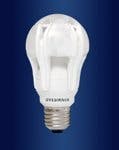LFI report, part 2: Retrofit lamps, modular SSL (MAGAZINE)
This article was published in the July/August 2011 issue of LEDs Magazine.
View the Table of Contents and download the PDF file of the complete July/August 2011 issue.
++++
LFI report, part 1: Linear LED lighting, OLED and planar lighting
LFI report, part 3: LED technology, outdoor lighting
++++
Section 3: Retrofit lamps
++++
We get the most out of LEDs in terms of energy efficiency and lighting performance from purpose-built fixtures. But the lure of existing sockets continues to bring players into the retrofit lamp market. LFI witnessed a number of demonstrations of LED lamps targeted at replacing 100W incandescent bulbs and 75W-equivalent lamps that are ready for market. There were also new LED-based lamps in the PAR, MR, and AR form factors.
Philips said that the lamp would soon undergo Energy Star testing and the lamp is based on a design similar to the 12.5W design that was the first 60W-equivalent product to win an Energy Star rating. Philips also demonstrated its Ledalite Jump luminaire that would be at home in our section on linear lighting.
++++
Section 4: Modular SSL
++++
Modular approaches to luminaire design allow lighting companies to more easily enter the SSL market, and that will become even more true as multi-vendor standards emerge. The Zhaga Consortium is closing in on standards for about a half-dozen different LED light-engine modules. There was a module in the TE Connectivity LFI booth that looked suspiciously like some Zhaga photos, but company spokespeople refused to comment on any Zhaga work. Meanwhile other companies are moving forward on different approaches to modules – for example some with inclusive drivers and others without.











